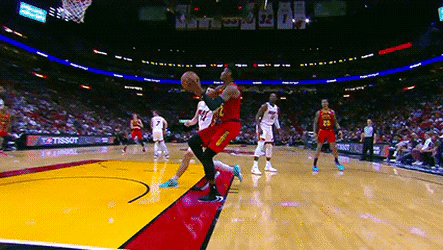A few years before Back to the Future seared the DeLorean into the national zeitgeist, the DeLorean Motor Company was being forecast as the next major entrant in the motor vehicleindustry. But by the early 80s, the lofty startup with a high valuation was hemorrhaging seed money after quality issues with the cars came to light. The DeLorean Motor Company wasted $100s of millions in seed capital, declared for bankruptcy and wound up being sued by its angry flock of celebrity investors. In the process they became a tale of caution about wasted potential and chasing unicorns even as the car John DeLorean staked his company’s reputation on became a cultural icon. There’s a thin line between visionary and fool. The interminable belief that new Knicks forward Cam Reddish may make the leap into superstardom may be the NBA equivalent of investing in the DeLorean Motor Company.
Through the first three seasons of his career, he hasn’t even been close. On Thursday, Reddish was traded to the Knicks as part of a package that included Solomon Hill and a future second round pick from Brooklyn, in exchange for Kevin Knox II as well as a 2022 first round pick from the Charlotte Hornets.
Fresh off a 21-point performance highlighted by 6-of-7 shooting from beyond the arc in Game 6 of the Eastern Conference Finals, the Reddish hive was buzzing with anticipation for his breakout season as recently as October. Instead, Reddish averaged a career-high 11.9 points per game on 40% shooting from the field despite improving his 3-point shooting efficiency from a ghastly 26% to a respectable 38%.
Even after an unremarkable two and a half seasons, Reddish is still viewed by the Knicks as a luxury worth a first-round pick and a $16 to $20 million multi-year extension after this season. The same franchise that has been notorious for overpaying decrepit former All-Stars or one-year-wonders are about to shell out a second round of funding this offseason, with the intent of receiving a return on investment tenfold. Given their track record, Reddish is the ideal young high-risk, high-reward player for the Knicks to invest in.
Reddish formed an underground army of fans in downtown Atlanta, who believed the Hawks had discovered lightning in a bottle and that he’d develop into Trae Young’s wing ace. Some even began referring to Reddish as Randy Moss on hardwood. However, beneath the veneer of unrealized potential, Reddish is Knox with better P.R.
The knock-on Reddish during his freshman year at Duke was his lack of a motor and poor shot selection. It makes sense considering prior to his arrival at Duke, he was a coveted playmaking point guard. The transition to off-ball wing has been rough. Before his senior year, shot 40 percent from the field on the EYBL circuit in 17 games and made only 29.7 percent of his threes. Then, at the Nike Hoop Summit, he shot 2-for-8 from the field, scoring seven points and getting son’d by RJ Barrett.
The thing I love about RJ Barrett is his motor. That’s the biggest difference between him and Cam Reddish right now. Barrett plays hard on every possession
— Eric Walden (@tribjazz) April 14, 2018
His only season at Duke only amplified those critiques. As the third option behind future No. 1 pick, Zion Williamson and Barrett, the expectation would be that a 6-foot-8, 217-pound talent with a 7-foot-1 wingspan, who earned comparisons to Paul George or T-Mac since he was 18 would be highly efficient scorer as the tertiary focus of defenses. However, Reddish was the inverse of Williamson’s young Shaq, as he struggled to find his shot and averaged a historically bad 35% shooting from the field and made fewer than 40% of his 2-pointers.
Three years ago, Reddish was even more of a rookie darling than Williamson. Despite being overshadowed by not one, but two of his Duke teammates throughout their freshman season, his peers divined that he would have the most distinguished career of the class of 2019 rookies.
Reddish continued to struggle as the sidekick to Trae Young, where he remained a drag on the Hawks resplendent offense. Since 2019, Reddish has shot 35.5 percent from the field and his effective field goal percentage ranks 304th league-wide, while Knox is 311th, second-worst in the league among qualified players behind only former Knick teammate Frank Ntilikina.
The worst-case scenario for the Knicks is that Reddish is already closer to his peak form than a Most Improved Player of the Year. It’s a reality the Hawks finally came to terms with gradually over the past three seasons as he averaged a sub-40% field goal percentage, while accumulating more turnovers than assists ever season. During his final half-season in Atlanta, Reddish drained only 42% on 2-point field goals, which would be second worst among all qualified players. He’s an abysmal 28.3% shooter on pull-up 3s, 30.2% on pullup 2s and 30 percent from midrange Js.
The Knicks press release announcing Reddish’s acquisition touts his career-high of 34 points against Orlando on Dec. 22, followed by his second-career 30-point effort five days later against Chicago. The press release failed to mention his 12-of-40 shooting including 25% shooting from downtown over the Hawks next four games.
.@nyknicks Acquire Cam Reddish pic.twitter.com/ldEQUoLZZm
— NY_KnicksPR (@NY_KnicksPR) January 14, 2022
The fanfare in Atlanta fizzled; however, the Knicks organization has never been shy about gambling on a risky investment. As currently assembled, they’re anchored down by a lack of elite upside. It remains to be seen if a change in scenery, the magic of MSG and if a new beginning away from the ball-dominant Trae Young can unlock Reddish’s All-Star potential. However, you can bet the Knicks are willing to take chance at any cost, even if it explodes in their faces like almost every bet they’ve maed in the past two decades.



